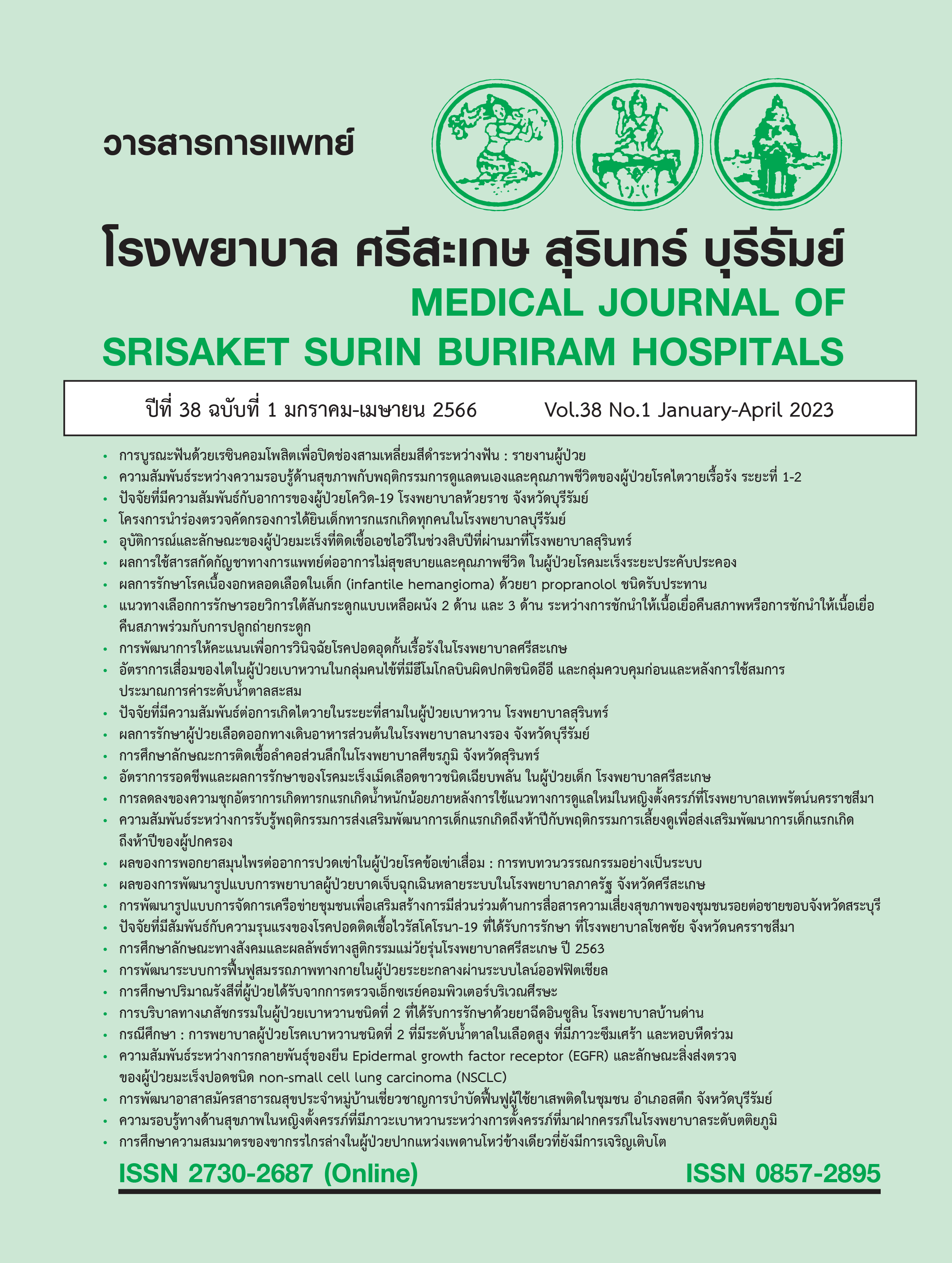Reduction in the Prevalence of Low Birth Weight Infants after Implementing of the New Antenatal Program for Pregnant Women at Debaratana Nakorn ratchasima Hospital
Main Article Content
Abstract
Objective: To access the effectiveness of the new antenatal program for high-risk pregnant women in 2019 by comparing the low birth weight prevalence in 2018 and 2021 at Debaratana Nakorn Ratchasima Hospital in Northeastern Thailand.
Methods: A cross-sectional observational study of pregnant women attending antenatal care (ANC) and giving birth at Debaratana Nakorn Ratchasima Hospital in 2018 and 2021. The study data were collected from medical records about maternal and neonatal outcomes. Data were analyzed by using descriptive statistics. Quantitative data were shown as means, standard deviation, range, median, and qualitative data were expressed as a percent and compare category data using Chi-square or fisher’s exact test
Results 852 cases were enrolled in this study, with 345 cases and 507 cases in 2018 and 2021 respectively. The LBW prevalence was 9.9% in 2018 and 6.3% in 2021, with a lowering of the LBW prevalence (3.5%) (p-value=0.06). A 269 high-risk pregnant women (53.1%) in 2021 had a statistically significant reduction in the LBW prevalence (p-value=0.01). Moreover, regarding the analysis found that the risk factors associated with a lowering of the LBW prevalence in our study were multiparous (p-value=0.04) preterm birth (p-value=0.005) pre-pregnancy weight more than 45 kg (p-value=0.02) pre-pregnancy body mass index 18.5 – 25 kg/m2 (p-value=0.03) poor weight gain (p-value=0.02) no history of previous preterm birth (p-value=0.048)
Conclusions: The new antenatal program in 2019 had a significant impact to decrease LBW incidences in high-risk pregnant women for LBW in our hospital.
Article Details

This work is licensed under a Creative Commons Attribution-NonCommercial-NoDerivatives 4.0 International License.
References
World Health Organization. Global nutrition targets 2025 : low birth weight policy brief; 2014. Geneva : World Health Organization; 2014.
Wardlaw T, Blanc A, Zupan J, Ahman E, The United Nations Children's fund, World Health Organization. Low birthweight: country, regional and global estimates. Geneva : World Health Organization ; 2005.
กรมอนามัย ระบบสารสนเทศสนับสนุนด้านการส่งเสริมสุขภาพและอนามัยสิ่งแวดล้อม. อัตราทารกแรกเกิดน้ำหนักน้อย (Low Birth Weight Rate) ระดับเขตสุขภาพ. [อินเตอร์เน็ต] 2565. [สืบค้นเมื่อ 15 กันยายน 2565]. ค้นได้จาก:URL:https://dashboard.anamai.moph.go.th/dashboard/lbwr/index?year=2021
Lee AC, Kozuki N, Cousens S, Stevens GA, Blencowe H, Silveira MF, et al. Estimates of burden and consequences of infants born small for gestational age in low and middle income countries with INTERGROWTH-21st standard: analysis of CHERG datasets. BMJ 2017;358:j3677. doi: 10.1136/bmj.j3677.
Laopaiboon M, Lumbiganon P, Rattanakanokchai S, Chaiwong W, Souza JP, Vogel JP, et al. An outcome-based definition of low birthweight for births in low- and middle-income countries: a secondary analysis of the WHO global survey on maternal and perinatal health. BMC Pediatr 2019;19(1):166. doi: 10.1186/s12887-019-1546-z.
Desta SA, Damte A, Hailu T. Maternal factors associated with low birth weight in public hospitals of Mekelle city, Ethiopia: a case-control study. Ital J Pediatr 2020;46(1):124. doi: 10.1186/s13052-020-00890-9.
Mangklabruks A, Rerkasem A, Wongthanee A, Rerkasem K, Chiowanich P, Sritara P, et al. The risk factors of low birth weight infants in the northern part of Thailand. J Med Assoc Thai 2012;95(3):358-65.PMID: 22550834
Pongcharoen T, Gowachirapant S, Wecharak P, Sangket N, Winichagoon P. Pre-pregnancy body mass index and gestational weight gain in Thai pregnant women as risks for low birth weight and macrosomia. Asia Pac J Clin Nutr 2016;25(4):810-7. doi: 10.6133/apjcn.092015.41.
Luangkwan S, Vetchapanpasat S, Panditpanitcha P, Yimsabai R, Subhaluksuksakom P, Loyd RA, et al. Risk Factors of Small for Gestational Age and Large for Gestational Age at Buriram Hospital. J Med Assoc Thai 2015;98 (Suppl 4):S71-8. PMID: 26201137
Chen Y, Li G, Ruan Y, Zou L, Wang X, Zhang W. An epidemiological survey on low birth weight infants in China and analysis of outcomes of full-term low birth weight infants. BMC Pregnancy Childbirth 2013;13:242. doi: 10.1186/1471-2393-13-242.
Triped O, Arj-Ong S, Aswakul O. Maternal Risk Factors of Low Birth Weight at Maharat Nakhon Ratchasima Hospital. Thai J Obstet Gynaecol 2012; 20(1);12-20.
Mumbare SS, Maindarkar G, Darade R, Yenge S, Tolani MK, Patole K.
Maternal risk factors associated with term low birth weight neonates: a matched-pair case control study. Indian Pediatr 2012;49(1):25-8. doi: 10.1007/s13312-012-0010-z.
Figueiredo ACMG, Gomes-Filho IS, Batista JET, Orrico GS, Porto ECL, Cruz Pimenta RM, et al. Maternal anemia and birth weight: A prospective cohort study. PLoS One 2019;14(3):e0212817. doi: 10.1371/journal.pone.0212817.
ปัญญา สนั่นพานิชกุล, ยศพล เหลืองโสมนภา. การตั้งครรภ์ในหญิงวัยรุ่น : ปัจจัยทางด้านมารดาที่มีผลต่อทารก. วารสารศูนย์การศึกษาแพทยศาสตร์คลินิก โรงพยาบาลพระปกเกล้า 2558;32(2):147-56.
Prasitlumkum M. Risk of Low Birth Weight and Adverse Pregnancy Outcomes in Adolescent Pregnancies at Chainat Hospital. Thai J Obstet Gynaecol 2009; 17(2):93-7.
Tantayakom C, Prechapanich J. Risk of Low Birth Weight Infants from Adolescent Mothers: Review Case Study in Siriraj Hospital. Thai J Obstet Gynaecol 2008; 16(2):103-8.
American College of Obstetricians and Gynecologists. ACOG Committee opinion no. 548: weight gain during pregnancy. Obstet Gynecol 2013;121(1):210–2.
สมาคมผู้ให้อาหารทางหลอดเลือดดำและทางเดินอาหารแห่งประเทศไทย. แบบประเมินภาวะโภชนาการ NAF (Nutrition alert form) . [อินเตอร์เน็ต] 2565. [สืบค้นเมื่อ 20 กันยายน 2565]. ค้นได้จาก:URL: AW_NAF_Form2016_3days (spent.or.th)
กรมอนามัย. แบบประเมินพฤติกรรมการบริโภคอาหารของหญิงตั้งครรภ์อายุ 19 ปีขึ้นไป. [อินเตอร์เน็ท]. 2565. [สืบค้นเมื่อ 20 กันยายน 2565]. ค้นได้จาก:URL: https://nutrition2.anamai.moph.go.th/web-upload/6x22caac0452648c8dd1f534819ba2f16c/filecenter/mother%20and%20child/a5-08.pdf.
กรมอนามัย แบบประเมินพฤติกรรมการบริโภคอาหารของหญิงตั้งครรภ์อายุ 14-18 ปี [อินเตอร์เน็ต] 2565. [สืบค้นเมื่อ 20 กันยายน 2565]. ค้นได้จาก:URL: https://nutrition2.anamai.moph.go.th/web-upload/6x22caac0452648c8dd1f534819ba2f16c/filecenter/mother%20and%20child/a5-09.pdf
กลุ่มงานสูตินรีเวชกรรมโรงพยาบาลเทพรัตน์นครราชสีมา. แนวทางการดูแลหญิงตั้งครรภ์ที่มีความเสี่ยงสูงต่อทารกน้ำหนักน้อย. 2565.


